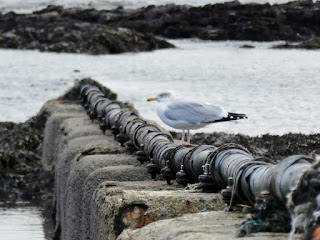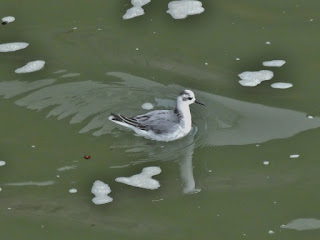Sunday 22nd November was forecasted to be an overcast day and with a high tide at around 10:30 I decided to take my usual lockdown River Plym and Saltram walk. However within half an hour of arriving on site a fine mizzle descended which became progressively heavier and after 3 hours I was quite damp and so gave up and headed home but I had an enjoyable walk anyway.
Blaxton Meadow was flooded on the high tide and out on the marsh were the usual Curlew, Oystercatcher, Dunlin and Redshank with Shelduck and Black-headed, Herring, Common and Great Black-backed Gulls. 7 Greenshank and 16 Wigeon (10 males) were also noted amongst them.
Out on the river in the murky conditions I found a Little Grebe, 4 Goosander (1 male) and a Great Northern Diver which dived as paddle boarders and a jet skier approached and was never refound.
Some shelter from the drizzle was afforded by the trees in Saltram Park and I was pleased to find a nice Firecrest in the trees above The Folly plus a few Goldcrest, a male Blackcap, a Jay, 5 Ring-necked Parakeets, 3 Stock Dove, an immature male Kestrel, 3 Redwing and a Nuthatch along with the usual common birds.
A Common Sandpiper showed very well along the river at Marsh Mills with a flyover Grey Wagtail heard calling but there was no sign of any Dippers on a quick scan around although not surprising given the high tide.
Friday 27th November was another gloomy day but I wanted to get out with my newly serviced binoculars and so I decided to revisit Wembury. It was chilly in the wind with increasing cloud cover as the day wore on but it was another enjoyable walk.
On arriving I picked up a small falcon flying overhead and heading out to sea. Initially I thought it was a Kestrel but on getting my newly serviced binoculars on it I realised it was in fact a female/juvenile Merlin. It continued to fly out to sea before dropping down low to the water and veering off towards Stoke Point until I eventually lost sight of it.
The Water Pipit was still present along the beach, busily feeding on the mass of seaweed near the sewage pipe with Rock Pipits and Meadow Pipits and being generally arsey as usual with any birds that came too close to it.
While watching the Pipits two small waders flew along the beach and landed on the rocks and at first I thought they were Turnstones but I was very pleased to see they were in fact Purple Sandpipers, my first at Wembury for quite a few years now.
Cirl Buntings were mobile and flighty along the footpath with males occasionally singing despite the cold weather and Stonechat were obvious too.
Along the beach a Curlew, 2 pairs of Mallard, a Little Egret and Oystercatchers were seen while offshore a few Gannets were noted along with small numbers of distant Auks flying east.
A Great Spotted Woodpecker, a male Bullfinch, a Goldcrest, a Song Thrush, 2 male Pheasent, a male Kestrel and a Buzzard were also seen before I headed home to warm up - a great walk as always and lovely to have my binoculars back.











































